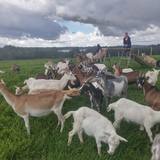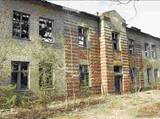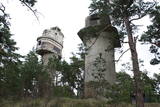| Nr | Nosaukums | Apraksts |
|---|---|---|
|
This long tour of Latvia includes some of the best and most beautiful parts of Jūrtaka in Latvia. Hikes along the sea alternate with trips and excursions in the cities. You will go along the coast of the Baltic Sea from Mazirbe to Kolka, seeing Slītere National Park and Livonian villages. You will see Engure Nature Park and the overgrown seaside meadows that are suitable for bird watching. Along the way, you will be able to purchase smoked fish from local fishermen and learn about fishing traditions in Latvia. Further, the route will take you through the most popular seaside resort in Latvia, Jūrmala; you will also have time to visit the capital city - Rīga. The second part of the route runs along the Vidzeme coast from Saulkrasti to Svētciems. In terms of landscapes and views, the most multifaceted section of the Baltic Coastal Hiking Route in Latvia, which includes both sandy and rocky beach, coastal meadows, reeds, dunes, sandstone outcrops, forests, capes and small coves, fishing villages and pubs. |
||
|
Unikāla ar savu 17. gs. attālāk no baznīcas celto zvanu torni. |
||
|
Pirmā Piņķos bija koka baznīca. Ideja par jauna dievnama celtniecību radās jau 19. gs. piecdesmitajos gados, taču šīs ieceres projekta gala varianta (arhitekts J. D. Felkso) pamatakmeni ielika 1872. gada 25. maijā. Mūsdienās redzamais dievnams celts laikā no 1872. - 1874. gadam. Deviņreģistru ērģeles izgatavoja pazīstamais ērģeļbūvētājs Vilhelms Zauers 1890. gadā. 1916. g. 17. jūlijā 5. latviešu strēlnieku bataljons, kas devās uz frontes līniju pie Smārdes, apstājās pie Piņķu muižas. Minētajā datumā Piņķu baznīcā pulkvedis Jukums Vācietis noturēja sprediķi (par šo faktu vēsturniekiem ir atšķirīgs viedoklis), kas iegāja Latvijas vēsturē kā viens no pašiem nozīmīgākajiem tā laika notikumiem. Vēsturiskais notikums Aleksandru Čaku rosināja to iemūžināta savā poēmā “Sprediķis Piņķu baznīcā”. Baznīca (kultūras piemineklis) apskatāma arī no iekšpuses. Diennakts tumšajā laikā tā ir izgaismota. Blakus baznīcai atrodas latviešu strēlnieku piemiņai uzstādītais akmens. |
||
|
Uzņēmums nodarbojas ar dabas tūrisma pasākumu organizēšanu: agrā pavasarī – izbraucieni ar plostiem, vasarā – laivošana ar smailēm (kopā ar bebru dzīves vērošanu), visu gadu – pārgājieni ar sniega kurpēm pa Igaunijas augstajiem un zemajiem purviem, ziemā – izbraucieni ar stumjamām ragaviņām. Pieredzējuši pārgājienu vadītāji pastāstīs interesantus notikumus un faktus par Igaunijas dabu un kultūru. |
||
|
Latgales novada rehabilitācijas centrs „Rāzna”. Nelielā uzkalniņā Zosnas ezera krastā, ieslēpusies gleznaina parka koku zaru vainagos, lepni slejas sanatorijas „Rāzna” ēka, kura pirmsākumos celta kā vasaras atpūtas nams māksliniekiem. Tā saista ar sakoptu parku un apkārtni. Vietējās nozīmes arhitektūras piemineklis. Ēku komplekss pilda ārstniecības iestādes funkcijas, piedāvājot plašu fizioprocedūru klāstu. Tūristiem ir pieejama naktsmītne. |
||
|
Maršruts “Baltijas ceļš” ir izveidots par godu unikālai akcijai 1989. gada 23. augustā, kad triju valstu iedzīvotāji sadevās rokās apmēram 600 km garā dalībnieku ķēdē un savienoja valstu galvaspilsētas – Viļņu, Rīgu un Tallinu. Vēsturiski šis ceļš izmantots un bijis zināms jau 14. – 15. gadsimtā un pat agrāk. Šajā reģionā graudaugu ēdieniem ir sena vēsture, daudzviet cep gardu rudzu ierauga rupjmaizi, Vidzemes pusē nogaršojiet to kopā ar kaņepju staku. Miežus cep karašās, vāra grūbu un bukstiņputrā. No kviešu miltiem cep ūdenskliņģerus ar ķimenēm. Graudu ceļam var izsekot zemnieku saimniecībās un atjaunotās vējdzirnavās. Vasaras saulgriežos daudzviet gatavo Jāņu sieru, ik dienas piedāvā arī citus gardus sierus no govs un kazas piena. Iecienītas dažādi gatavotas upju un ezeru zivis, vietējo mājlopu un mājputnu ēdieni, arī medījumi, aizdarīti ar gardām mērcēm. Dzīvas uguns dūmi sulīgam cepetim vai karstai zupai piešķir jauku smaržu. Piedevās – saknes un zaļumi, pupas, zirņi un sēnes. Zupām un salātiem pievieno savvaļas augus: skābenes, pieneņu, gārsu un jauno nātru lapiņas. Palutiniet sevi ar svaigu medu, speķa pīrāgiem, plātsmaizēm, kliņģeriem, saldēdienu no rudzu maizes, medus kūkām un piparkūkām. Piedāvājumā atradīsiet gan vienkāršus tradicionālos ēdienus, gan romantiskus mielastus pilīs un muižās, gan īpašu bruņinieku mielastu ar Livonijas laikam raksturīgu garšvielu izmantošanu. Slāpes var veldzēt ar zāļu tējām, bērzu sulām, ogu dzērieniem, gardu alu, vīnu vai stiprāka dzēriena glāzīti. |
||
|
Udmurdu un citu somugru nacionālo ēdienu meistarklašu rīkošana, citu tautu kultūras apgūšana caur ēdienu. |
||
|
Kalēja smēdē apmeklētāji var vērot kalēju darbībā. Šeit var pasūtīt no metāla darinātus dekoratīvos elementus, žogus un citus izstrādājumus pēc individuālas vienošanās. |
||
|
Meklējams Mazā Ludzas ezera ziemeļaustrumu krastā. Muzeja brīvdabas nodaļā iepazīstama zemnieka dzīvojamā māja (dūmistaba), dzīvojamā ēka, vējdzirnavas, rija un Latgales keramiķa Polikarpa Vilcāna darbnīca. Tā teritorijā tiek organizēti ar amatniecību un dažādiem kultūras notikumiem saistīti pasākumi. Vieta, kas Latgales kultūras izziņas nolūkā, ir noteikti jāapmeklē. Blakus muzejam atrodas plosta piestātne izbraucieniem pa Mazo Ludzas ezeru (pēc iepriekšēja pieteikuma) un atpūtas vieta. |
||
|
Audzētavas apmeklētājiem gida pavadībā piedāvā staltbriežu, dambriežu un muflonu apskati ar stāstu par dzīvnieku audzēšanas īpatnībām. Veic selekcijas darbu. |
||
|
Atrodas Bauskas vēsturiskajā centrā, Plūdoņa ielā 13 a un ir šīs pilsētas daļas vecākā ēka. Dievnams celts 1591. - 1594. g. vēlās gotikas stilā, bet tornis piebūvēts 1614. g. Baznīcas iekšpusē atrodas nozīmīgi mākslas pieminekļi: altāris (1699. g., pārbūvēts 1861. g., mākslinieks J. Dērings), kancele (1762. g.) un ērģeļu prospekts (1766. g.) – abi Nikolaja fon Korfa dāvinājums, draudzes soli (17. gs. vidus – 18. gs. sāk.), senākais no koka veidotais Bauskas ģerboņa attēlojums (1640. g.), deviņas 16. – 17. gs. kapu plāksnes, epitāfijas u.c. Baznīca, kurā ir vērts ieiet! |
||
|
Jauns Zoo un izklaides vieta netālu no Siguldas, pie ceļa Turaida - Ragana. Tiks atvērts 2022. gada maijā. |
||
|
Piemājas saimniecībā, kas atrodas netālu no Jumurdas ezera, ražo kazas sieru, ko iegūst no 40 slaucamām kazām (kopā – 60 kazas). Produkciju var iegādāties uz vietas, kā arī mājražotāju tirdziņos. Produktus piegādā pēc pieprasījuma. Saimniecībā notiek ekskursijas – iepazīšanās ar kaziņu Boniju, viņas draudzenēm un siera degustācija. |
||
|
Jūras apsardzes rajons ar zenītraķešu divizionu Miķeļtornī tikusi īpaši veidota Padomju savienības ārējās robežas aizsardzībai. Pašlaik teritorijā tiek izmantota tikai robežsargu bijušā teritorija, kur izvietots Ventspils krasta apsardzes bataljona novērošanas punkts.
|
||
|
Atrodas Rēzeknes centrā, Atbrīvošanas alejas vidū. Latgales atbrīvošanas piemineklis “Vienoti Latvijai” ir piemiņas zīme vēsturiskā novada atbrīvošanai un Latvijas vienotībai. Bronzas pieminekli atklāja 1939. g. (tēlnieks K. Jansons, L. Tomašicka ideja). 1940. g. novembrī padomju vara centās to iznīcināt, bet pieminekli atjaunoja 1943. g. augustā. 1950. g. jūnijā sekoja otrais pieminekļa iznīcināšanas mēģinājums, kas bija veiksmīgs. Pēc Latvijas neatkarības atjaunošanas tautā saukto “Latgales Māru” trešo reizi uzstādīja 1992. g. 13. augustā (pēc saglabātajiem metiem veidojis K. Jansona dēls - A. Jansons). „Latgales Māra” ir uzskatāma par vienu no labākajiem Latvijas monumentālās tēlniecības paraugiem. Māras tēls tautas mitoloģijā tiek personificēts ar zemes auglību un dzīvības sargātājas ideju, bet krusts ir kristīgās ticības simbols. |
||
|
Saimniecība atrodas tradicionālajā zvejnieku ciematā, un šeit ir cieņā vietējie ēdieni un rokdarbi. Viesiem tiek piedāvāts degustēt pašgatavotos produktus, kā arī šeit rīko ēdiena gatavošanas un amatniecības meistarklases un iepazīstina ar lauku dzīvi. |
||
|
Šo batereju visvieglāk atrast ir ejot gar jūras krastu, jo viena no četrām tās pozīcijām atrodas liedagā – jūras viļņu noskalota. Pārējās pozīcijas, tālmēra tornis un citi elementi atrodas netālu no jūras krasta – priežu mežā. Batereja celta pagājušā gadsimta četrdesmitajos gados. No šīs krasta baterejas jau redzami Ziemeļu forti
|
||
|
Jūrmalas pilsēta (piektā lielākā Latvijā) dibināta 1959. g., apvienojot Ķemeru un Slokas pilsētas ar Rīgas pilsētas Jūrmalas rajonu. Tā stiepjas 32 km garā Rīgas jūras līča piekrastes posmā. Jūrmalas kūrorts savulaik bija viens no nozīmīgākajiem šāda veida objektiem Ziemeļeiropā. To sekmēja vietējā un starpvalstu transporta un satiksmes (diližanss, tvaikoņi, vilciens) attīstība. Pirmos peldviesus uzņēma Dubultos, kur 1834. g. uzcēla pirmo viesnīcu, bet 1847. g. - pirmo kūrmāju. 19. gs. sāka darboties pirmās ārstniecības iestādes. No 1834. g. sākās strauja vasarnīcu izbūve. Kūrorta attīstību pārtrauca 1. pasaules karš. Pēc tā atkal bija vērojams straujš kūrorta uzplaukums no 12 tūkstošiem (1920. g.) līdz 32 tūkstošiem (1935. g.) atpūtnieku. Līdztekus Jūrmalai attīstījās arī Ķemeru kūrorts, kas masveida atpūtnieku raksturu ieguva padomju periodā. Mūsdienās Jūrmala ir populāra koncertu, festivālu, izstāžu, sporta sacensību u.c. publisku pasākumu norišu vieta. |
||
|
Naktsmītnē Elly, Kihnu salā gatavo mājas saldējumu, piedāvā arī naktsmītni un gardas mājas brokastis. |
||
|
Krodziņš Raudnaela atrodas Pärnu–Tartu šosejas malā, kādreizējā Raudna kroga (1700. g.) vietā, 15 minūšu braucienā no Viljandi. Viesi varēs nobaudīt garšīgu mājas ēdienu, šeit tiek organizētas arī tematiskās vakariņas. |
||


























